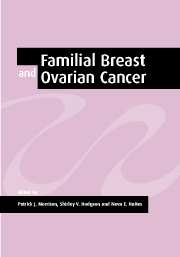Book contents
- Frontmatter
- Contents
- List of contributors
- Foreword by Helena Kennedy
- Preface
- Acknowledgements
- Part 1 Molecular biology and natural history
- Part 2 Screening
- 9 Developing a cancer genetics service: a Welsh model
- 10 Referral criteria for cancer genetics clinics
- 11 Guidelines for the development of cancer genetics services
- 12 Cultural and educational aspects influencing the development of cancer genetics services in different European countries
- 13 Screening, detection and survival patterns of breast and other cancers in high-risk families
- 14 Screening for familial ovarian cancer
- Part 3 Management
- Index
11 - Guidelines for the development of cancer genetics services
Published online by Cambridge University Press: 24 August 2009
- Frontmatter
- Contents
- List of contributors
- Foreword by Helena Kennedy
- Preface
- Acknowledgements
- Part 1 Molecular biology and natural history
- Part 2 Screening
- 9 Developing a cancer genetics service: a Welsh model
- 10 Referral criteria for cancer genetics clinics
- 11 Guidelines for the development of cancer genetics services
- 12 Cultural and educational aspects influencing the development of cancer genetics services in different European countries
- 13 Screening, detection and survival patterns of breast and other cancers in high-risk families
- 14 Screening for familial ovarian cancer
- Part 3 Management
- Index
Summary
Most countries now have services for familial cancer genetics, but these vary considerably (Harris, 1998; Hodgson et al., 2000). There are, broadly, three potential approaches for developing a clinical service in response to the growing evidence of the links between inherited genetic factors and the risks of developing breast and ovarian cancers:
An ad hoc system of providing advice to patients, i.e. ‘demand led’
The development of a selective system of screening patients who are estimated to be at relatively high genetic risk of developing these cancers
The establishment of systems of population screening to identify patients at increased risk
Over the last few years, many clinics worldwide have been providing advice to patients with a family history of cancer through clinics in an ad hoc and uncoordinated manner, funded largely through ‘soft money’. The resources available have not kept pace with the rapid growth in demand, and this is reflected in the sharp increase in waiting times for appointments in recent years.
Only 5% of breast and ovarian cancers are thought to be due to a strong inherited susceptibility. A process of selection of individuals who are estimated to be at high risk on the basis of their family history for screening for cancer is a more pragmatic approach than screening the general population. However, it is important to demonstrate clearly the benefit of such surveillance programmes before this can be advocated on a large scale (Scottish Office Home and Health Department, 1998).
- Type
- Chapter
- Information
- Familial Breast and Ovarian CancerGenetics, Screening and Management, pp. 166 - 193Publisher: Cambridge University PressPrint publication year: 2002
- 2
- Cited by



